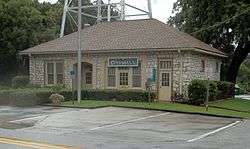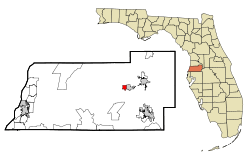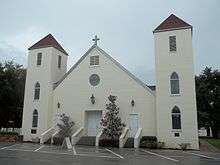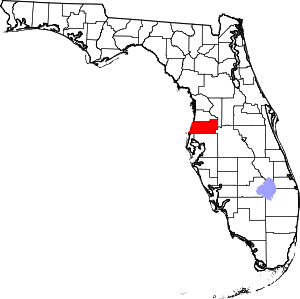San Antonio, Florida
San Antonio, or unofficially San Ann as the locals call it, is a city in Pasco County, Florida, United States. It is a suburban city included in the Tampa-St. Petersburg-Clearwater, Florida Metropolitan Statistical Area. It lies within Florida's 5th congressional district. The population was 1,138 at the 2010 census. It was established as a Catholic colony by Judge Edmund F. Dunne.[5] The city derives its name from Saint Anthony of Padua.[6][7] Saint Leo University is located nearby.
San Antonio Lake Jovita (1927–33) | |
|---|---|
 San Antonio City Hall | |
| Nickname(s): San Ann, San An | |
| Motto(s): "Gem of the Highlands" | |
 Location in Pasco County and the state of Florida | |
| Coordinates: 28°20′12″N 82°16′30″W | |
| Country | United States |
| State | Florida |
| County | Pasco |
| Government | |
| • Type | City Commission |
| • Mayor | Mark Anderson |
| • Commissioner (Mayor Pro Tem) | Elayne Bassinger |
| • Commissioner | James Markley |
| • Commissioner | Sarah Schrader |
| • Commissioner | John Vogel II |
| Area | |
| • Total | 1.36 sq mi (3.53 km2) |
| • Land | 1.36 sq mi (3.53 km2) |
| • Water | 0.00 sq mi (0.00 km2) |
| Elevation | 167ft/469ft ft (51/201 m) |
| Population (2010) | |
| • Total | 1,138 |
| • Estimate (2019)[2] | 1,475 |
| • Density | 1,083.76/sq mi (418.32/km2) |
| Time zone | UTC-5 (Eastern (EST)) |
| • Summer (DST) | UTC-4 (EDT) |
| ZIP code | 33576 |
| Area code(s) | 352 |
| FIPS code | 12-63375[3] |
| GNIS feature ID | 0290470[4] |
| Website | www |
Geography
San Antonio is located at 28°20′12″N 82°16′30″W (28.336649, −82.275011).[8]
According to the United States Census Bureau, the village has a total area of 1.2 square miles (3.1 km2), all land.
History

San Antonio was founded (in name only) in 1881 by Edmund F. Dunne who previously had been chief justice of the Arizona territory.[9] Dunne was a legal counsel involved in the Disston Land Purchase, and as his commission, received 100,000 choice acres (400 km2) of land out of the 4,000,000 acre (16,000 km2) purchase. The following year on February 15, while surveying the Disston Purchase with his cousin, Captain Hugh Dunne, he came upon a previously unsurveyed lake with crystal clear water. Seeing in a prayer book that it was the feast day of St. Jovita, he named the lake after the early Christian martyr.[10] Judge Dunne selected the city's location on Jovita's western shore and began settling it in earnest. He established the city as the center of a Catholic colony in Florida. Dunne planned several other villages for the surrounding area including St. Thomas, Villa Maria, Carmel and San Felipe, but only the rural community of St. Joseph survives today. In 1889 the Benedictines established the monastery of St. Leo and St. Leo College on Dunne's former homestead and farm land, later incorporating the area as part of a separate town, St. Leo, Florida. At about the same time, five Benedictine sisters established Holy Name Convent in the center of San Antonio. The nuns had come to teach at two local schools (St. Anthony School and St. Joseph School), as well as to establish Holy Name Academy. The sisters had the convent and the academy physically moved by oxen to a 40-acre parcel in St. Leo overlooking the southwestern shore of Lake Jovita in 1911. The nuns remained at St. Anthony School until the end of the 2009–10 academic year. At the time of its founding San Antonio was located in the southern third of Hernando County, as Pasco County was not created until 1887. The Orange Belt Railway first began service to San Antonio in November 1887.[11] For a short time beginning in 1927, the city officially changed its name to the town of Lake Jovita, only to revert to San Antonio in 1933.[10][12]
Demographics
| Historical population | |||
|---|---|---|---|
| Census | Pop. | %± | |
| 1910 | 131 | — | |
| 1920 | 262 | 100.0% | |
| 1930 | 322 | 22.9% | |
| 1940 | 267 | −17.1% | |
| 1950 | 286 | 7.1% | |
| 1960 | 479 | 67.5% | |
| 1970 | 473 | −1.3% | |
| 1980 | 529 | 11.8% | |
| 1990 | 776 | 46.7% | |
| 2000 | 655 | −15.6% | |
| 2010 | 1,138 | 73.7% | |
| Est. 2019 | 1,475 | [2] | 29.6% |
| U.S. Decennial Census[13] | |||
As of the census[3] of 2000, there were 655 people, 270 households, and 180 families residing in the village. The population density was 532.2 inhabitants per square mile (205.6/km2). There were 286 housing units at an average density of 232.4 per square mile (89.8/km2). The racial makeup of the village was 97.25% White, 1.07% Asian, 0.31% from other races, and 1.37% from two or more races. Hispanic or Latino of any race were 6.41% of the population.
There were 270 households, out of which 33.7% had children under the age of 18 living with them, 54.8% were married couples living together, 10.7% had a female householder with no husband present, and 33.3% were non-families. 29.3% of all households were made up of individuals, and 7.4% had someone living alone who was 65 years of age or older. The average household size was 2.43 and the average family size was 3.03.
In the village the population was spread out, with 27.2% under the age of 18, 8.4% from 18 to 24, 29.3% from 25 to 44, 24.0% from 45 to 64, and 11.1% who were 65 years of age or older. The median age was 36 years. For every 100 females, there were 92.6 males. For every 100 females age 18 and over, there were 87.1 males.
The median income for a household in the village was $43,125, and the median income for a family was $58,750. Males had a median income of $39,375 versus $27,031 for females. The per capita income for the village was $20,287. About 9.8% of families and 10.1% of the population were below the poverty line, including 15.7% of those under age 18 and 14.6% of those age 65 or over.
Controversial 2000 census data
In a story that wound up on the front page of The New York Times, many of the 2000 census numbers were disputed by the City Clerk of San Antonio based on the fact the city had 336 residential water customers at the time.[14] The Clerk further asserted that most of the residents received their mail via post office box, which the US Census Bureau would not send forms to.[15] City officials speculated that the population that year was probably closer to 900,[16] which would be more consistent with the growth reflected in data collected in other cities throughout the county, as well as Pasco County as a whole.[17][18] The 2010 census count of 1,138 residents was considered to be much more accurate.[19]
Education

San Antonio is home to two schools. Saint Anthony Catholic School (grades Kindergarten – 8) traces its roots to the Fall of 1883 when local widow Cecilia Morse began teaching colony children in her home. By April 1884 it was officially established as a Catholic school and is by far the oldest school of any kind in Pasco County.[9][10] In fact it actually predates the county by several years. San Antonio Elementary (grades Kindergarten – 5) was founded 98 years later in 1981 and though its campus lies entirely within San Antonio's city limits, its mailing address is actually Dade City, Florida.[20] Holy Name Academy (grades 1 – 12) was established in 1889 as an "all-girls" boarding school by the Benedictine Sisters of Florida, but moved to the neighboring town of St. Leo in 1911.
Notable people
- Chris Arnade, former Wall Street trader and documentarian, grew up in San Antonio.[21]
References
- "2019 U.S. Gazetteer Files". United States Census Bureau. Retrieved July 2, 2020.
- "Population and Housing Unit Estimates". United States Census Bureau. May 24, 2020. Retrieved May 27, 2020.
- "U.S. Census website". United States Census Bureau. Retrieved 2008-01-31.
- "US Board on Geographic Names". United States Geological Survey. 2007-10-25. Retrieved 2008-01-31.
- http://www.sanantoniofla.com/index.php?option=com_content&view=article&id=50&Itemid=34
- Blackstone, Lillian (Mar 23, 1952). "Into center of state". St. Petersburg Times. p. 19. Retrieved 1 November 2015.
- Dayton, William G. "A Short History of the San Antonio Area". Retrieved 23 May 2016.
- "US Gazetteer files: 2010, 2000, and 1990". United States Census Bureau. 2011-02-12. Retrieved 2011-04-23.
- http://www.fivay.org/san_antonio.html
- Horgan, James J. (1990). Pioneer College: The Centennial History of Saint Leo College, Saint Leo Abbey, and Holy Name Priory. Saint Leo, FL. Saint Leo College Press. ISBN 978-0-945759-01-0
- A short history of San Antonio Archived 2015-09-02 at the Wayback Machine
- Jeffares, Carol (April 30, 1988). "Communities changed names to fit new times". Tampa Tribune. p. 2D. Retrieved December 3, 2017.
- "Census of Population and Housing". Census.gov. Retrieved June 4, 2015.
- Kinsler, Laura (March 17, 2010). "Making it count". Tampa Tribune. p. C1. Retrieved November 21, 2017.
- Kinsler, Laura (April 8, 2010). "Counting on an exact population". Tampa Tribune. p. C1. Retrieved November 21, 2017.
- Kinsler, Laura (March 22, 2010). "San Antonio hopes this year's census goes smoother than last". Tampa Tribune. p. 5. Retrieved November 21, 2017.
- Kinsler, Laura (April 12, 2010). "Census effort puts San Antonio into the spotlight". Tampa Tribune. p. 5. Retrieved November 21, 2017.
- Kinsler, Laura (June 6, 2010). "Locals annoyed by census". Tampa Tribune. p. C1. Retrieved November 21, 2017.
- Pleasant, Rachel (March 19, 2011). "San Antonio stands up and is counted". Tampa Tribune. p. C1. Retrieved November 21, 2017.
- http://www.fivay.org/saint_joseph.html
- Wirz, Matt (11 August 2017). "Wall Street Trader Chris Arnade Seeks Redemption for 'Intellectual Grift'". Wall Street Journal.
External links
| Wikimedia Commons has media related to San Antonio, Florida. |
- City of San Antonio official site
- San Antonio Area Information A private community site with local happenings
- History of San Antonio (Fivay.org)
